When Encaustic is painted on Plexiglass, the beauty of translucent wax and the transparency of plexiglass combine to create luminous works.
When I first heard about painting on plexiglass with encaustic I was sceptical. We always say that encaustic needs an absorbent surface to adhere properly and Plexiglass is not absorbent. But there are many examples of artists successfully painting on plexiglass with encaustic wax medium.
In Encaustic Art The Complete Guide to Creating Fine Art with Wax, Lissa Rankin writes, “From an artistic standpoint, Plexiglas and wax are a perfect marriage. As ambient light shines through a painting on Plexiglas, the painting takes on great luminosity, appearing to glow.”
Examples of Encaustic on Plexiglass
Visit these websites for inspiration and proof that yes, you can paint with wax on plexiglass:
- https://heatherhutchison.com/
- http://www.scottreillyart.com/
- http://www.ediemorton.com/
- https://www.dustygriffith.com/
Tips for Painting with Wax on Plexiglass
- Remove the paper backing from one side of the Plexi
- Unless you intend to work on both sides of the Plexi, initially leave the paper backing on the back of your piece to protect it as you work. At some point, you will need to remove the paper so you can hold it up and let the light shine through.
- Begin by warming the surface of Plexi with a heat gun. Avoid using a blow torch, it’s intense heat may warp the Plexi.
- Some artists rough-up the surface with sandpaper, I didn’t do this. I don’t want the scratch marks to show and it doesn’t seem to be necessary
- Add a layer of Liquitex Clear Gesso and let it dry completely. This will create tooth and improve adhesion of the wax to the plexi
- Work in thin translucent layers to allow light to shine through
- Incise lines and gently scrape back to keep the layers of wax thin and let the light in
If you are concerned about how archival the piece will be, do an encaustic freezer test.
Displaying Encaustic on Plexiglass
Think about how you are going to display the work before you begin.
If the work is small, you can drill a hole in the top of the Plexiglass and, with fishing line, hang it in a window from a suction cup. Plexiglass is lightweight and can easily be hung in this way. I have a piece I did two years ago and it still looks the same as when I made it. The exposure to sunlight has not altered it at all. Damar resin in encaustic medium raises the melting point, the sun has not softened the wax. On a few occasions, the suction cup has released and the piece has fallen to the floor, without any adverse effects.
When working larger, you’ll want to ensure that the plexiglass is well supported to prevent flexing and bending. The artists linked above either mount their work so natural light will illuminate the piece or have built light-boxes.
My Experiments with Encaustic on Plexiglass
These experiments were a lot of fun. Hanging the piece in a window, so the daylight shines through, changes it considerably.


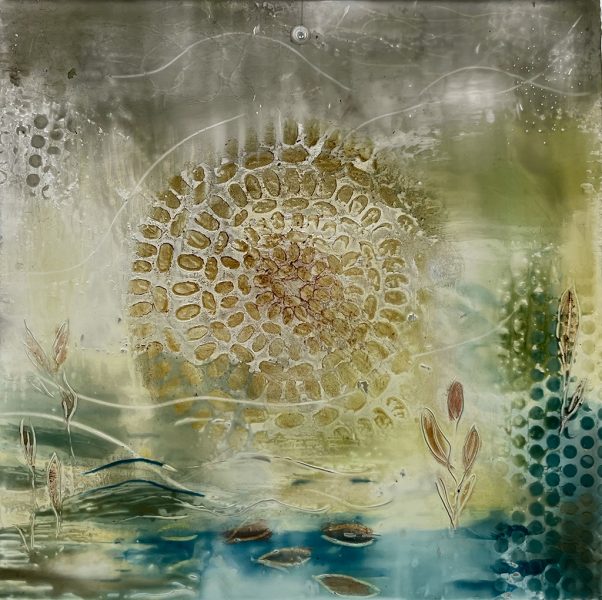
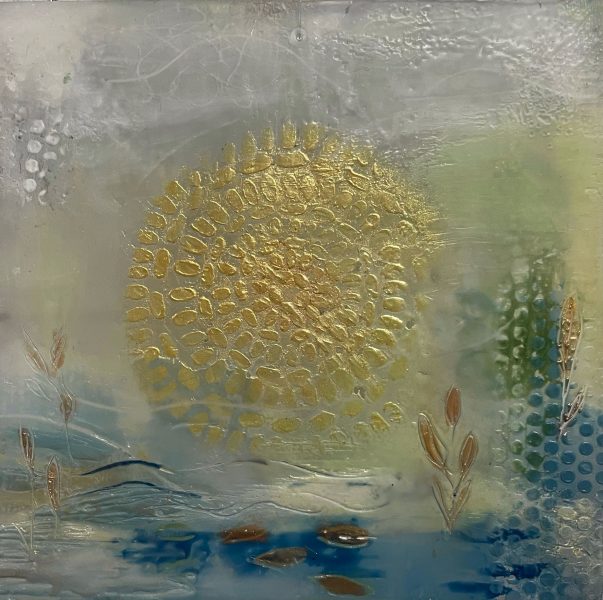

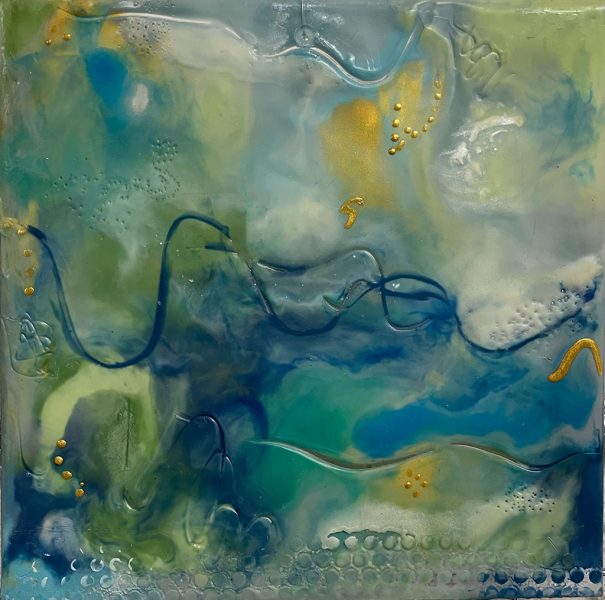
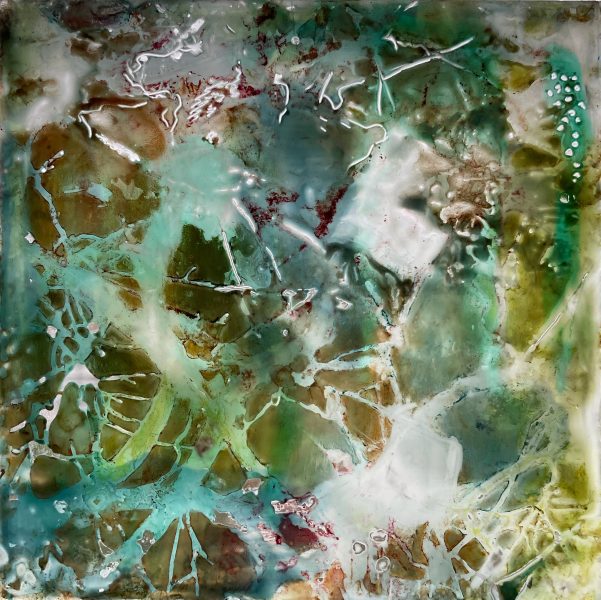



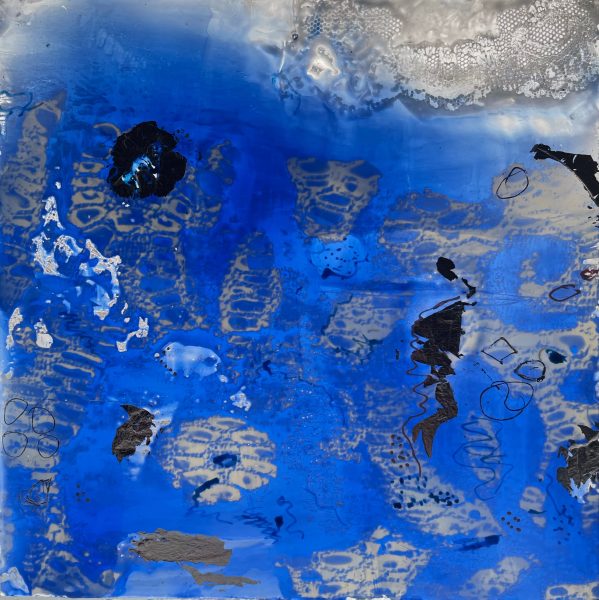


For this work, I purchased a floating wall mount frame with spacers from Amazon. I found that the spacers were too modern with this vintage photo so I used wooden thread spools instead.
I digitally combined two photos creating a double exposure. I printed the photo onto rice paper. I taped off the area where the image is and created a flat base of encaustic medium. I carefully positioned the image and ironed it into the wax. Read about this process here.
Have you painted with Encaustic on Plexiglass?
Please leave a comment and me know about your experience. You can also join the All Things Encaustic Facebook Group and post photos of your work.
- Encaustic Underpainting using a Stay-Wet Palette - February 13, 2024
- Cardboard as a Substrate for Encaustic Painting - November 20, 2023
- Create Three-Dimensional Structures With Fosshape - April 2, 2023
- How to reuse encaustic scrapings - February 2, 2023
- Christina Lovisa’s Homemade Paste for Collage - December 12, 2022
- Glass As A Substrate For Encaustic Painting! - November 8, 2022
- How to organize your art studio - October 21, 2022
- Create Beautiful Cyanotype Prints To Use In Encaustic Paintings - September 13, 2022
- How To Do An Encaustic Pour For Outstanding Results - July 12, 2022
- The Best Way To Paint A Smooth Encaustic Surface - June 24, 2022






Hello – I’m an oil painter and have been using cold wax for awhile , but feel like it’s time to add encaustic to my toolbox! The question I have right now: I would like to make a large (18×60?) interior window in my house and was planning on stained glass till I saw this post about working on plexiglass and your examples of illumination and the piece you hung in a window. With your experience do you think a large size is feasible? I would plan mount it the same way I would a stained glass piece, in a properly framed opening. It would receive daylight from both sides, but not direct sun.
I’m so excited to find your blog and website, loved the links you provided for the artists and book, very helpful and exciting!
Thanks – Terry
Hi Terry, Here’s a post about working on a window https://allthingsencaustic.com/encaustic-glass/. Yes this is possible but that at that size this isn’t a beginner project. I think you’re best to until you’re comfortable with your tools and working with encaustic medium before tackling this project.
Thanks for the information!
This is beautiful and so different.
what thickness of plexi are you using? and any thought about whether you can adhere a piece of rice paper…
thanks….
Hi Alice I think that mine are 3 mm or 1/8 inch thick.
I haven’t tried adding rice paper but I don’t see why not.
Hi how could you mount the finished plexiglass for display if it was a bigger piece?
Thanks Ruth…i love to experiment with different materials…i work in Encaustic Monotypes presently. Do you thinks i can print on the plexi and transfer the paint using a Roland Hot Box? Heats to about 170 degrees.
Give it a try! I think it should work. Let me know how it goes 🙂
This is very inspiring, I had no idea this could marry, so Thanks for sharing it, Ruth. Beautiful works and the artist links as well, all breathtaking. The transparency is what we all love about the medium, seeing into the depths; this makes it so vibrant!
I’ve used encaustic on plexiglass for years. Worried about flex with thick wax areas but haven’t had a problem. Clients place in backlit boxes or windows ( not direct sun). This encouraged me to use “encaustiflex” and have light shine through. I break the rules a lot and would take any piece back if a client has any kind of issue.